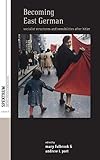Becoming East German : Socialist Structures and Sensibilities after Hitler / ed. by Andrew I. Port , Mary Fulbrook.
Material type: TextSeries: Spektrum: Publications of the German Studies Association ; 6Publisher: New York ; Oxford : Berghahn Books, [2013]Copyright date: ©2013Description: 1 online resource (314 p.)Content type:
TextSeries: Spektrum: Publications of the German Studies Association ; 6Publisher: New York ; Oxford : Berghahn Books, [2013]Copyright date: ©2013Description: 1 online resource (314 p.)Content type: - 9780857459749
- 9780857459756
- 943.10874 23
- DD283 .B427 2013
- online - DeGruyter
| Item type | Current library | Call number | URL | Status | Notes | Barcode | |
|---|---|---|---|---|---|---|---|
 eBook
eBook
|
Biblioteca "Angelicum" Pont. Univ. S.Tommaso d'Aquino Nuvola online | online - DeGruyter (Browse shelf(Opens below)) | Online access | Not for loan (Accesso limitato) | Accesso per gli utenti autorizzati / Access for authorized users | (dgr)9780857459756 |
Frontmatter -- CONTENTS -- PREFACE -- ABBREVIATIONS -- INTRODUCTION The Banalities of East German Historiography -- PART I Memory and Identity after Nazism -- CHAPTER 1 East Germans in a Post-Nazi State: Communities of Experience, Connection, and Identification -- CHAPTER 2 Divisive Unity: The Politics of Cultural Nationalism during the First German Writers’ Congress of October 1947 -- CHAPTER 3 Communicating History: The Archived Letters of Greta Kuckhoff and Memories of the “Red Orchestra” -- CHAPTER 4 Remembered Change and Changes of Remembrance: East German Narratives of Anti-fascist Conversion -- PART II Health, Food, and Embodied Citizens -- CHAPTER 5 Perceptions of Health after World War II: Heart Disease and Risk Factors in East and West Germany, 1945–75 -- CHAPTER 6 Socialism Fights the Proletarian Disease: East German Efforts to Overcome Tuberculosis in a Cold War Context -- CHAPTER 7 The Slim Imperative: Discourses and Cultures of Dieting in the German Democratic Republic, 1949–90 -- CHAPTER 8 Luxury Dining in the Later Years of the German Democratic Republic -- PART III Constraints and Conformity: Friends, Foes, and Disciplinary Practices -- CHAPTER 9 Predispositions and the Paradox of Working-Class Behavior in Nazi Germany and the German Democratic Republic -- Chapter 10 Israel as Friend and Foe: Shaping East German Society through Freund- and Feindbilder -- CHAPTER 11 Humiliation as a Weapon within the Party: Fictional and Personal Accounts -- CHAPTER 12 Playing the Game: Football and Everyday Life in the Honecker Era -- CONCLUSION Structures and Subjectivities in GDR History -- CONTRIBUTORS -- INDEX
restricted access online access with authorization star
http://purl.org/coar/access_right/c_16ec
For roughly the first decade after the demise of the GDR, professional and popular interpretations of East German history concentrated primarily on forms of power and repression, as well as on dissent and resistance to communist rule. Socio-cultural approaches have increasingly shown that a single-minded emphasis on repression and coercion fails to address a number of important historical issues, including those related to the subjective experiences of those who lived under communist regimes. With that in mind, the essays in this volume explore significant physical and psychological aspects of life in the GDR, such as health and diet, leisure and dining, memories of the Nazi past, as well as identity, sports, and experiences of everyday humiliation. Situating the GDR within a broader historical context, they open up new ways of interpreting life behind the Iron Curtain – while providing a devastating critique of misleading mainstream scholarship, which continues to portray the GDR in the restrictive terms of totalitarian theory.
Mode of access: Internet via World Wide Web.
In English.
Description based on online resource; title from PDF title page (publisher's Web site, viewed 25. Jun 2024)


